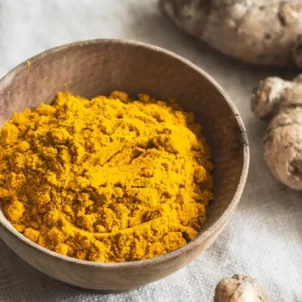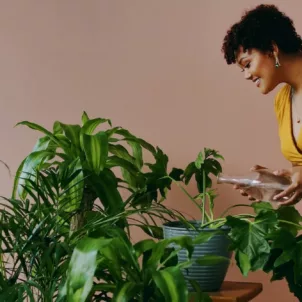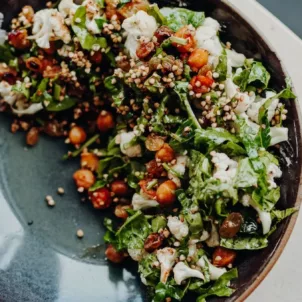Want to develop your green thumb? Here’s a complete guide on how to grow herbs for beginners—plus the health benefits of herbs.
Discovering you can actually grow your own food is a pretty magical moment. Maybe it happened to you as a small child watching your grandfather tend to his expansive garden, or maybe it didn’t hit you until you snagged a potted basil plant from Trader Joe’s and managed to keep it alive long enough to make a delicious pesto. Maybe it hasn’t happened for you yet (just wait!). In a world where many of us are insulated from the agricultural process, the act of growing your own food can seem cathartic and downright revolutionary.
If you’ve been wanting to try your hand at growing edible crops for a while but don’t know where to start, herbs are the gateway you’ve been looking for. Not only are they endlessly useful, but they’re super accessible. Walk into any hardware store or plant nursery on the hunt for seeds, and you’ll find yourself rich with possibilities—from classic options like basil and parsley to more bespoke picks like tarragon and nettle. Another perk? Herbs aren’t picky about their growing conditions. As some of the most adaptable plants out there, herbs can thrive in a variety of different climates and need just the slightest bit of TLC to really take off. Translation: Whether your available garden space is a city balcony or a few sunny acres of land, you can bet your little herbs will be happy either way. Ready to get started? Here’s our guide on how to grow herbs for beginners.
Why Grow Your Own Herbs?
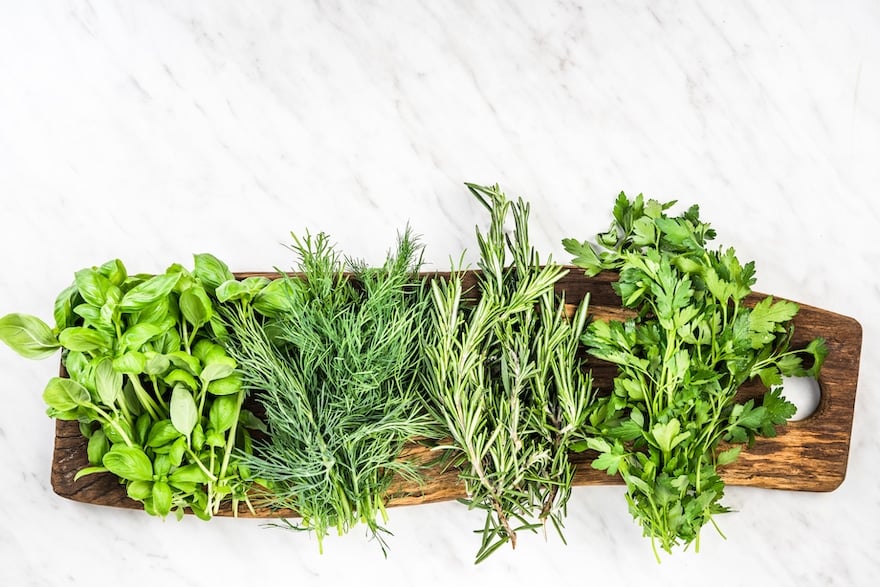
To some, spending weeks (or even months) tending to sprouts in the hopes of one day adding mint to your smoothie may seem a bit excessive—especially considering you’re likely able to have all the herbs you could ever want at your fingertips with just one trip to the grocery store. Still, there’s something to be said for dedicating time and energy towards growing any food, including something as simple as herbs.
And who knows? Gardening could be just the hobby you need to slow down and destress a bit from daily life. According to a study by a Texas A&M AgriLife Extension Service specialist, keeping your hands and mind busy by gardening—and spending time in nature—can lead to increased self-esteem, a boosted mood, reduced anger, and lower levels of anxiety and depression. What’s more, a study out of the University of Colorado Boulder determined that microorganisms in soil can promote stress resilience and reduce the risk of mood disorders. So not only will you get nutritional benefits from eating whatever you grow, but you can also count on some mental health benefits, too.
Sustainability is another core consideration when it comes to growing your own herbs. Will growing your own cilantro save the planet? Probably not. But even in some small way, growing your own herbs can help take some of the pressure off of an already taxed global food system that’s suffering at the hands of population increases and climate change. Another perk? Many herbs (think: rosemary, thyme, cilantro, dill, and lavender) are beloved by important pollinators, like bees and butterflies, granting them renewed resources that are untouched by dangerous pesticides. The moral of the story: When you’re growing herbs, you’re not only benefiting your health (and tastebuds)—you’re impacting the world around you.
Health Benefits of Herbs
When it comes to growing herbs for consumption, think of them as one more tool in a holistic toolbox designed to help you achieve your best, healthiest self. “I like to think of herbs as an easy way to add nutrition to meals,” says HUM dietitian and trichologist Samaria Grandberry, RDN. “Sometimes people can be overwhelmed with trying to get in the recommended amount of fruits and vegetables, but I always tell clients that adding in herbs counts as nutrition. They’ve been a cornerstone of different cultures for centuries and are a great way to get in extra minerals and nutrients.”
Whether you’re looking to boost your overall health or target a specific issue (like digestive problems), there’s an herb ready to help. Grandberry sees a lot of clients dealing with inflammatory issues, and credits herbs like turmeric, rosemary, peppermint, and lavender with helping quell those flare-ups. “I also love to use aloe vera on the scalp of my clients or recommend it for internal use—the gel can act like a lubricant for people who are dealing with things like inflammatory bowel issues,” she adds. “Marshmallow root is another herb I love—you can add to soups or smoothies to help target digestive issues.”
Here’s a look at some popular, easy herbs to grow and their basic health benefits:
- Peppermint: Digestive health (you’ll find peppermint in HUM’s Flatter Me), cardiovascular and pulmonary health, muscle relief
- Parsley: A good source of antioxidants, carotenoids, Vitamin K; a natural diuretic
- Oregano: Contains antioxidants and phytochemicals that can help strengthen the immune system, reduce inflammation, and regulate blood sugar; a good source of Vitamin E
- Basil: High in antioxidants and phytochemicals; has antimicrobial benefits
- Thyme: A good source of Vitamin A, Vitamin C, and manganese
- Cilantro: A good source of Vitamins A, C, K, and E; can help reduce inflammation
- Rosemary: Antioxidant-rich, with anti-inflammatory benefits; a good course of calcium, iron, and Vitamin B6
Best Herbs to Grow for Beginners
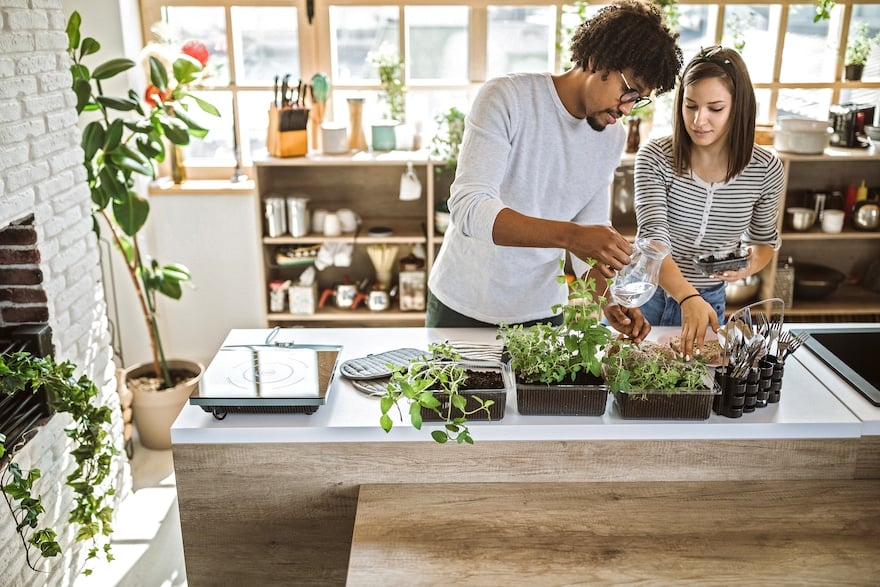
While the herbs you choose to grow depend a lot on your personal preference and needs, there are a few easy-going varietals that are great for novice plant people. “If you’re looking to grow herbs from seed, start with varietals that have watery stems, like basil, cilantro, and chives,” suggests Arianna Iappini, the gardening expert and coach behind The Birch Arbor Gardens. “These herbs are fast-growing and the seeds tend to have higher germination rates when directly sown into the soil outdoors.” Herbs with woodier stems, like rosemary, thyme, and oregano, can take a lot longer to get started and may provide a greater harvest if you begin with started plants from your local nursery, Iappini adds.
But the main benefit of growing herbs at home is having a greater diversity or variety to select from, Iapinni says. “You also get the benefit of time, which is helpful if you live in a cooler climate with a short growing season,” she says. “In a larger garden, herbs can make excellent companions for plants like tomatoes, peppers, and eggplants, since many of the aromatic varieties like thyme, rosemary, and basil can help to deter pests away from the main food crops.”
How to Grow Herbs at Home
Ready to start growing herbs at home? You’ll want to first consider a few things. To start, where do you want to grow your herbs? Most will do well indoors or outdoors (provided you’re in the proper growing season for them to be outdoors), so it comes down to personal preference and how larger of a crop you’re looking to grow. If you’re looking to grow herbs in the off-season, indoors is your best bet. However, the instructions for both will be mostly the same—here’s how to do it:
Step 1: Fill Your Containers
Whether you’re starting herbs from seed or caring for a plant that’s already been grown at a nursery, you’ll want to start by filling up your containers with dirt. Terracotta pots are best for herbs, as they’ll help wick excess water from the soil to prevent too much moisture. Make sure your chosen pot has ample drainage holes in its base. Fill with a lightweight potting soil that has been amended with some extra nutrients (think: worm castings, organic matter, or compost). (Yep, your plants need supplements, too.)
Step 2: Plant Your Herbs
If starting your herbs from seeds, you’ll need to plant them according to package instructions. In most cases, this means burying several seeds about ½-inch deep and covering them with soil—however, some herbs (like thyme) need light to germinate and should not be covered with soil at all.
If you’re potting up herbs that are already established, gently remove the plant from its nursery container and loosen the root ball slightly with your fingers. Plant the herb in your pot (or garden) slightly deeper than it was in the nursery pot, and cover it with soil, patting firmly.
Step 3: Water Your Herbs
Using a watering can, gently saturate your pots until the soil is moist but not soggy. Many herbs started from seed can benefit from base watering—if you choose to go that route, place your pots in a tray filled with water so the soil can absorb water from the base of the pot. Check on your herbs every few days—they will benefit from some time in-between waterings, but the soil should never be allowed to completely dry out.
Step 4: Place Your Herbs Somewhere Sunny
So, how much sunlight do herbs need to grow? As a general rule of thumb, they need between six and eight hours of bright sunlight daily. Place your pots next to a bright and sunny window, or put them on a cart that can be moved around your home or yard throughout the day to “chase” the sun. If you don’t have ample sunlight in your home or garden, it may be a good idea to invest in herb grow lights to guarantee that your herbs are getting all the vitamin D they need.
Step 5: Plant Out in Your Garden (Optional)
Remember, herbs aren’t picky: If you want to continue growing herbs indoors in pots once starting them from seed, feel free to do so. However, if you want to add them to your garden outdoors, make sure to wait until after a strong root system is established and all danger of frost has passed.
That’s all there is to it! Before your know it, you’ll have a bevy of delicious herbs at your disposal, ready to be added to your smoothies, soups, teas, poultry, and more.

